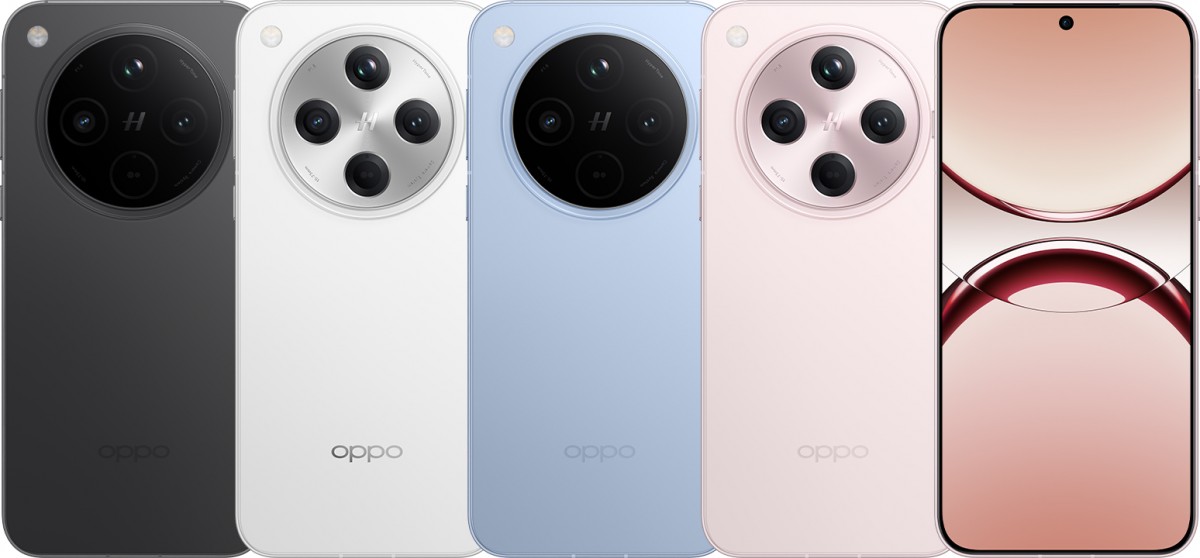Oppo has officially unveiled its latest flagship phones, the Oppo Find X8 and Find X8 Pro, at a launch event in China.
Both models bring notable upgrades across design, display, performance, and cameras, positioning them as strong contenders for the best phones of 2024.
However, we’re still waiting for the Find X8 Ultra and a rumoured brand-new Find X8 Mini. With a global launch event now confirmed, here’s everything you need to know about the Find X8 series.
When will the Oppo Find X8 be released?
The Oppo Find X8 and X8 Pro series were announced at an event in China on 24 October 2024, before shipments began six days later.
Oppo has now confirmed that the Find X8 Series will be launching globally at an event in Bali, Indonesia on 21 November 2024.
This marks a change in strategy for Oppo, which chose not to release the Find X6 and Find X7 ranges outside its native China.
But how many models will actually be launching on 21 November? The Find X8 and X8 Pro are highly likely to be on the agenda, but what about a successor to the excellent Find X7 Ultra?
What’s more, according to reputable source Digital Chat Station (via GSMArena), Oppo may also introduce a fourth model, the Find X8 Mini, alongside the Ultra variant. However, even if that phone launches at some point, it may never be released outside China.
How much does the Oppo Find X8 cost?
The Oppo Find X8 comes in four colours: Starfield Black, Floating Light White, Chasing Wind Blue, and Bubble Pink.
Pricing starts at CNY 4,199 (around £485/$590) for the base model with 12GB RAM and 256GB of storage.
For those wanting more storage, the high-end version with 16GB RAM and 512GB storage is priced at CNY 4,999 (approximately £575/$700).

Oppo
Meanwhile, the Oppo Find X8 Pro is available in Hoshino Black, Cloud White, and Sky Blue.
Prices start at CNY 5,299 (about £615/$745) for the 12GB RAM/256GB model and go up to CNY 6,799 (around £790/$955) for the 16GB RAM/1TB model, which includes satellite communication capabilities.

Oppo
The Find X7 series wasn’t available globally so it’s hard to determine how much the Find X8 series might actually cost in the UK and Europe.
The Find X7 Ultra retailed for CNY 5,999 in China (around £800/$1000), so expect the Find X8 Ultra to be priced similarly.
As for the Mini model, we also have no concrete information on how much it could cost. It will probably be a little less or a little more than the CNY 4,199 (around £485/$590) price of the standard Find X8.
What specs and features will the Oppo Find X8 have?
Design
Oppo has introduced a refined, compact design for the Find X8 series.
Both the standard and Pro models incorporate Oppo’s new ‘Cosmos Ring’ camera island, a visually striking feature that’s smaller than previous models but packed with powerful hardware.
The design is sleek, with clean lines and a slightly curved back that makes the phone comfortable to hold.
The Find X8’s colour palette includes sophisticated shades like Starfield Black and the vibrant Bubble Pink, providing options ranging from understated to bold.

Oppo
The Pro model’s larger body not only allows for a more advanced periscope lens but also houses a ‘Quick Button,’ a practical addition for camera control that adds a tactile element to the design. It remains to be seen how similar this is to Apple’s Camera Control button.
Additionally, the alert slider makes a return, allowing users to instantly switch sound profiles. Both models also have an IP69 rating, making them highly resistant to water and dust.
As you might expect, leaker Digital Chat Station expects the Find X8 Mini to be a small-screen flagship, though it’s not clear exactly how compact it’ll be, or if any key specs are compromised to make it smaller.
Display
Oppo has paid significant attention to the Find X8’s display, making it one of the highlights of the device.
The Find X8 features a 6.59-inch flat LTPO OLED panel with FHD+ resolution and a 1-120Hz adaptive refresh rate, providing smooth scrolling and enhanced responsiveness. This versatile display is designed to conserve battery life by adjusting the refresh rate based on usage.

Oppo
On the other hand, the Find X8 Pro boasts a larger 6.78-inch LTPO OLED display with FHD+ resolution, which uses a micro-quad-curved design, a unique approach that combines a mostly flat panel with subtle curvature on all four edges.
Both displays can achieve up to 1,600 nits peak brightness for standard use and an impressive 4,500 nits peak brightness for HDR content, making them among the brightest screens on the market.
Both models include an optical fingerprint scanner for seamless unlocking and have a 32MP front-facing camera embedded in the screen.
The Find X8 Mini will almost certainly have a smaller display than the regular Find X8 (6.59-inches), but that’s all we know about its screen at this stage.
Performance
Performance is a major upgrade in the Oppo Find X8 series, as these are the first Oppo devices to feature MediaTek’s Dimensity 9400 chipset. This powerful processor, combined with an advanced cooling system, promises a smooth experience for both everyday tasks and high-performance applications.

Oppo
The cooling system integrates a graphite layer, a vapour chamber, and thermal conductive gel applied directly to the motherboard, potentially allowing for better heat management during prolonged gaming or multi-tasking. This setup should help to prevent overheating, ensuring the phone runs efficiently even under heavy loads.
According to leaked Geekbench 6 test results, the Dimensity 94000 phone can achieve scores of 2,876 for single-core and 8,987 for multi-core performance. The chip uses a big-core structure with 1 Cortex-X5 core clocked at 3.4GHz, 3 Cortex-X4 cores at 3.3GHz, and 4 Cortex-A720 cores at 2.4GHz.
Another leak on Weibo (via GSMArena) reveals the Find X8’s performance on the AnTuTu benchmark, running MediaTek’s upcoming Dimensity 9400. The chipset achieved an impressive score of 2,880,558 on AnTuTu 10, surpassing the Snapdragon 8 Gen 3 and Apple’s M4, though cross-platform comparisons aren’t always the most reliable.
The Dimensity 9400, featuring 1 Cortex-X5 core at 3.4 GHz, 3 Cortex-X4 cores at 3.3 GHz, and 4 Cortex-A720 cores at 2.4 GHz, is built on TSMC’s 3nm N3E process.
Cameras
The Find X8 series features an advanced camera system that caters to both casual photographers and photography enthusiasts.
The Find X8 model includes a main camera with a 50Mp Sony LYT-700 sensor, featuring a 1/1.56-inch size and a 24mm equivalent lens with optical image stabilisation (OIS) for sharp, stable images.
Its ultrawide camera uses a 50Mp ISOCELL JN5 sensor with autofocus and a 15mm equivalent lens, perfect for wide landscapes and group shots.
The telephoto camera has a 73mm 3x periscope lens with an IMX882 sensor (1/1.95-inch size) and OIS, utilising a compact triple prism design to save space without compromising zoom quality.

Oppo
In the Find X8 Pro model, the ultrawide and 3x telephoto cameras from the Find X8 are retained, but the main camera is upgraded to a 50Mp LYT-808 sensor with a larger 1/1.4-inch sensor size for enhanced detail and improved low-light performance.
Additionally, the Pro model introduces a secondary periscope camera with a 50Mp sensor and 6x optical zoom for capturing high-quality images from greater distances.

Oppo
Oppo’s HyperTone image engine combines nine RAW frames for each photo, enhancing clarity and dynamic range while reducing noise. The Hasselblad Portrait Mode offers a distinct portrait style, while LivePhoto captures brief video segments before and after each shot, adding contextual depth to still images.
Exclusive to the Pro model, the ‘Quick Button’ (rather similar to the iPhone 16 Camera Control) provides convenient camera access and functions as a dedicated shutter and zoom control.
Battery & Charging
While the Find X8 is equipped with a 5630mAh battery, the Find X8 Pro features a larger 5910mAh cell, making it ideal for users who need extended battery life.
Both models support 80W wired charging and 50W wireless charging.
Software
The Oppo Find X8 series runs on the newly released ColorOS 15, based on Android 14. However, an update to Android 15 will likely be available by the time it arrives in Europe.
ColorOS 15 focuses on improving user experience through smart, adaptive features such as optimised battery management, personalised app suggestions, and advanced privacy settings.
Oppo has also integrated AI capabilities that adjust settings based on user patterns, and a new system theme is designed to be both visually pleasing and functional.
Enhanced privacy tools allow users to better manage app permissions and sensitive data, while AI-driven optimisation ensures that the phone runs smoothly throughout its lifecycle.

Oppo
This is all we currently know about the Oppo Find X8 series. In the meantime, check out our lists of the best Android phones in 2024.













